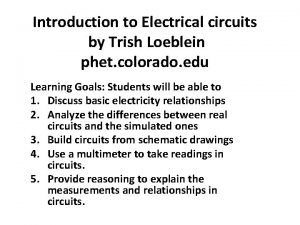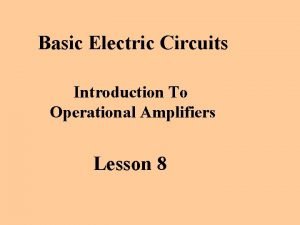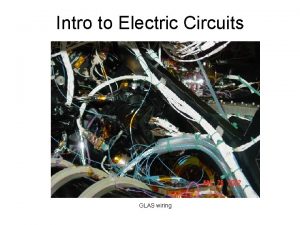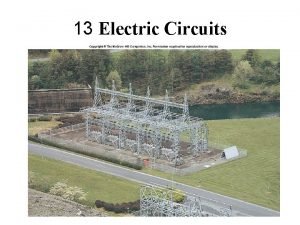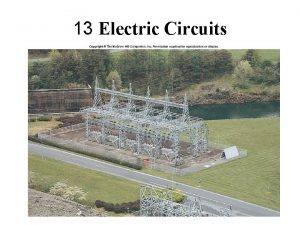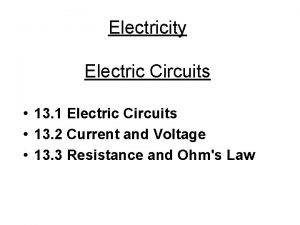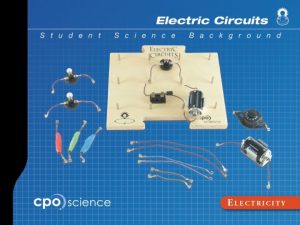Electric Circuits Circuits control the movement of electric










- Slides: 10

Electric Circuits • Circuits control the movement of electric current by providing paths for electrons to follow. • The path of an electric circuit is a closed pathway. • An electric circuit allows electrons to flow from a negative pole (excess electrons) to a positive pole (deficient in electrons)

Electric Circuits All circuits need three basic parts: an energy source, wires, and the object that is going to change the electrical energy into another form of energy (load). Energy Source Wire Load

Parts of an Electric Circuit • Energy source-can be a battery, a photocell, thermocouple, or an electric generator at a power plant. • Wires-connect the other parts of a circuit. Wires are made of conducting materials that have low resistance such as copper. • Loads-change the electrical energy into other forms of energy which include: • Thermal Energy • Light Energy • Mechanical Energy • Sometimes a circuit also contains a switch that is used to open and close a circuit. • Loads create resistance when they change energy from one form to another. Car Fan Toaster

Connections in a Circuit § Electrons flow from negative to positive; therefore, a complete circuit must have wires that connect the negative pole of the energy source to the positive pole of the energy source. § The circuit is established when there is a continuous path for electricity to travel from one end of the energy source to the other end.

The illustrations below show four ways in which a simple circuit can be made.

Series Circuit • In a Series Circuit there is only one path for the electric current or electricity to flow. • All of the loads in a series circuit share the same current. • Because the current in each bulb is the same, the lights in the circuit glow with the same brightness (power) if they have the same resistance. • If there is any break in the circuit, the charges will stop flowing. • When you add more bulbs in a series circuit, the resistance would increase so the current would decrease and the bulbs would be dimmer (less power) • To find the total resistance of a series circuit add the resistance of all the items (R 1 + R 2 + R 3 +… = Rtotal)

Parallel Circuit • In a Parallel Circuit there is more than one path for the electric current or electricity to flow. • The electric current branches so that electrons flow through each of the paths • If one path is broken, electrons continue to flow to the other paths • In parallel circuits the parts are joined in branches such that the “potential difference” (voltage) across each part is the same. • The loads in parallel circuits do not have the same current. • Branches with lower resistance get more current.

More on Parallel Circuits • “Electricity takes the path of least resistance” • Instead of the same current, each load in a parallel circuit uses the same voltage. • Because each bulb uses the full voltage, each bulb glows at full brightness, if they have the same resistance, no matter how many bulbs are connected. • The total resistance of a parallel circuit gets smaller as you add more branches. (1/R 1 + 1/R 2 + 1/R 3 +… = Rtotal)

Comparing Series & Parallel • What are the advantages of using a parallel circuit to a series circuit. • The load in a parallel circuit will still work if one of the loads is broken or missing. You can use one load at a time, even it another load fails. § Voltage is the potential difference between two points in a circuit. § As voltage increases, more electrical potential energy is available to be changed into other forms of energy. § Basically, higher voltage means a faster flow of electrons or electric current.

Comparing Series & Parallel • In a Series circuit, the current has to travel through each bulb; therefore, adding more light bulbs makes each bulb dimmer because the resistance of the whole circuit has increased. • Resistance is how difficult it is for electrons to flow through a material (friction). • Another advantage of a Parallel circuit is that you can connect loads that need different currents to the same parallel circuit. • For example, you can connect a hair dryer, which needs a high current to run, to the same circuit as a lamp, which needs less current to run.
 Series parallel circuit current
Series parallel circuit current Phet circuit construction kit
Phet circuit construction kit Fundamentals of electric circuits chapter 4 solutions
Fundamentals of electric circuits chapter 4 solutions Chapter 20 electric circuits
Chapter 20 electric circuits Conceptual physics chapter 35
Conceptual physics chapter 35 Chapter 20 electric circuits
Chapter 20 electric circuits Electric circuits equations
Electric circuits equations 9
9 Fundamentals of electric circuits chapter 7 solutions
Fundamentals of electric circuits chapter 7 solutions Chapter 35 electric circuits answers
Chapter 35 electric circuits answers Electric circuits nilsson
Electric circuits nilsson

